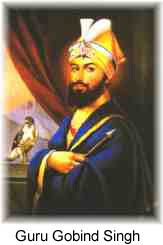

 |  |
 Throughout world history it has been seen that continued persecution of humanity has lead to the birth of exemplary personalities. Who with their vision beyond the limit of time has changed the due course of history. One such person was Guru Gobind Singh.
Throughout world history it has been seen that continued persecution of humanity has lead to the birth of exemplary personalities. Who with their vision beyond the limit of time has changed the due course of history. One such person was Guru Gobind Singh.Guru Gobind Singh (1666-1708) was an Indian spiritual leader, who turned Sikhism from a sect trying to traverse a middle path between Hinduism and Islam into a warring tribe, to fight the persecution Sikhs and Hindus were facing in the hands of Aurangzeb. He was the tenth and last guru (teacher) of the Sikh religion. He founded the order called the Khalsa (pure) in 1699. Gobind Singh was born in Patna, Bihar, India. His father Guru Tegh Bahadur, was the ninth Sikh guru. In 1675, Guru Tegh Bahadur was executed by order of the Mughal emperor Aurangzeb. Gobind Singh became the new guru. He had a mission in life to resist Aurangzeb and avenge his fathers death. He instilled a new spirit of patriotism among the Hindus in general and the Sikhs in particular. In order to save himself from the attack of Aurangzeb he shifted his activities to the hilly areas of Punjab. In 1679 Guru Gobind Singh convened a general meeting of the Sikhs at Anandpur Sahib in the Baisakhi day and laid the foundation of Khalsa (or the pure). There he chose five of his disciples as Panj Piaras (the beloved five) whom he baptized by offering them water stirred with a sword, which he called Amrit or Pahul. The Sikhs were given a new name of Khalsa (or the pure) and were asked to add Singh (meaning lion) to their names. The members were to observe a code of conduct that included the visible symbols called the "five k's": kesh (uncut hair), kangha (a comb), kirpan (a dagger), kara (a steel bangle), and kachh ( a pair of shorts). The emergence of the Khalsa was a challenge to Aurangzeb. He tried to curb the Sikhs military power by attacking them. The Sikhs put up a brave front even though it meant sacrificing their lives. In 1708 a Pathan, who pretended to be disciple of the Guru, stabbed him. With the death of Guru Gobind Singh, the line of Sikh Gurus ended. Guru Gobind Singh had announced the end of personal Guruship. The Adi-Granth renamed as Guru Granth Sahib was declared the eternal spiritual Guru of the Sikhs. Guru Gobind Singh was a great military genius and fierce warrior. He was also a scholar of Persian, Hindi, Sanskrit and Gurumukhi. He wrote Vachitra Natak (an autobiography describing his mission in the world) and Jap Sahib. He also wrote poems, which appear in a collection called the Dasam Granth. His letters to Aurangzeb has been collected into a book Zafar Namah in Persian. next page >> |
Copyright ©2000 indiansaga.info. All rights reserved.
By using this service, you accept that you won't copy or use the data given in this website for any commercial purpose.
The material on indiansaga.info is for informational & educational purpose only.
This site is best viewed at 800 X 600 picture resolution.